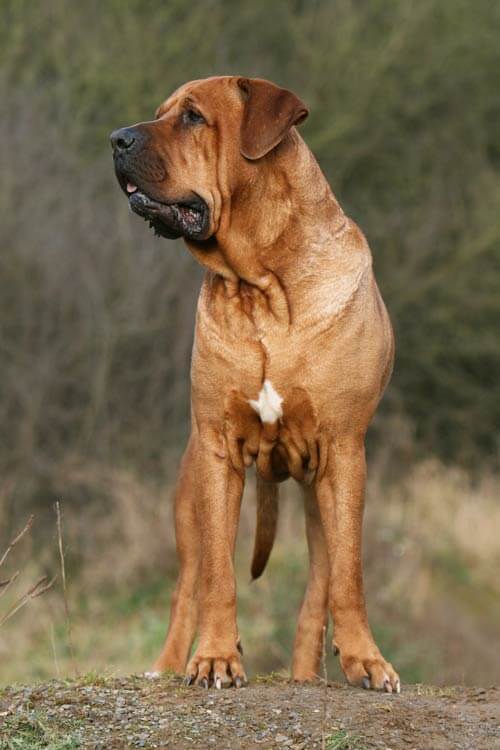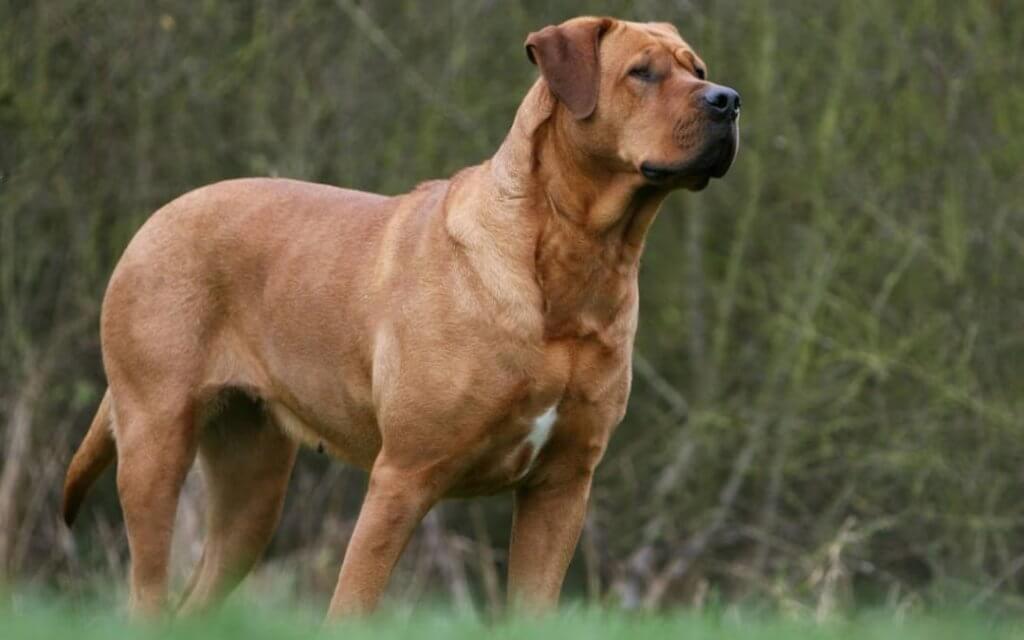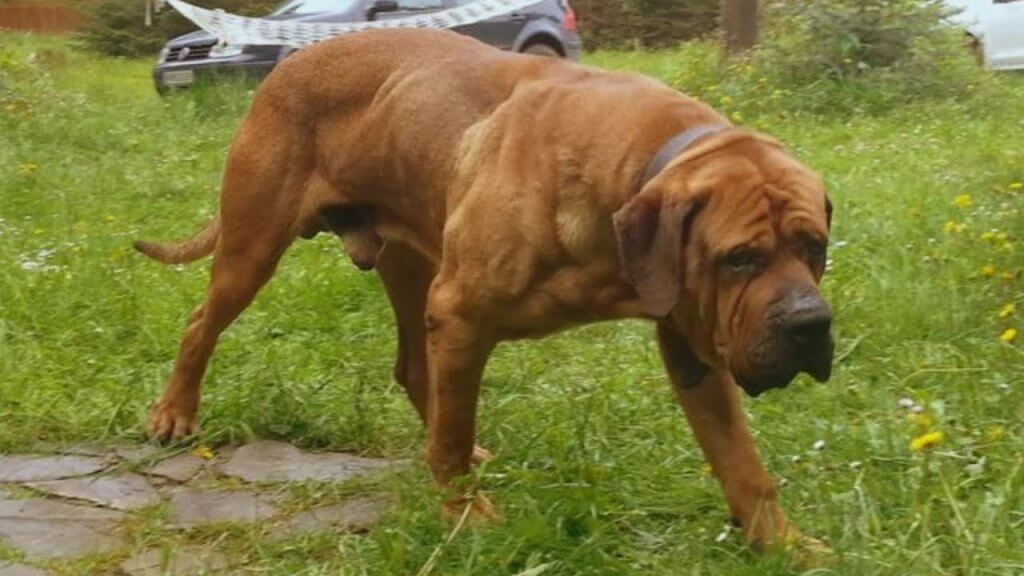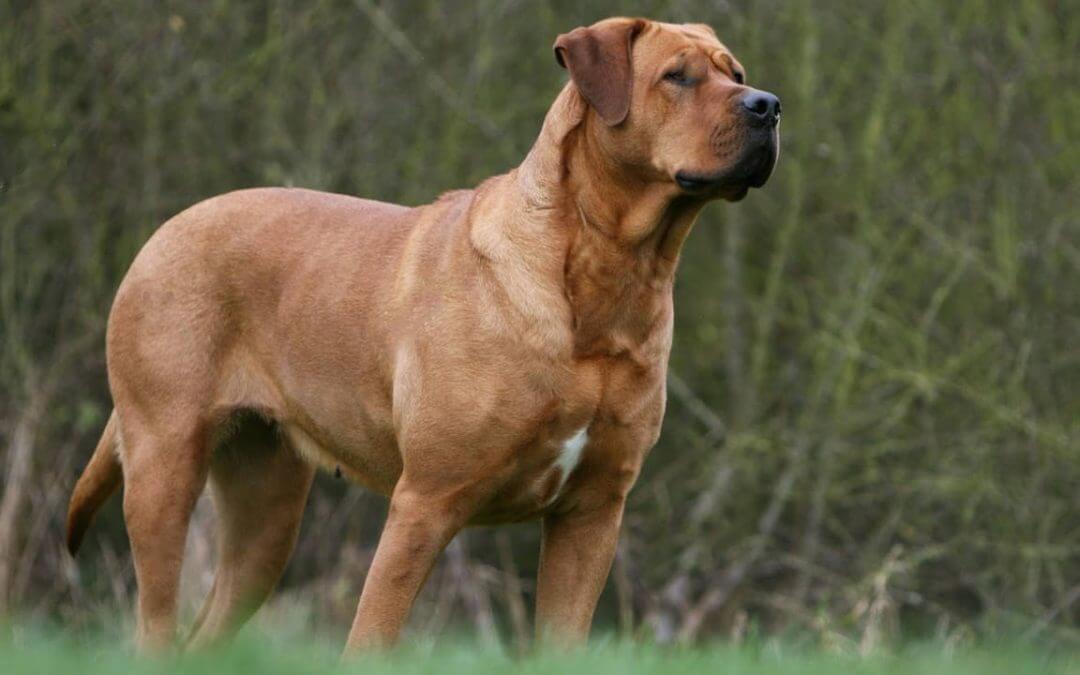The Tosa is also known as Tosa Inu or Japanese Mastiff. It was originally bred in Tosa as a fighting dog and still is today. Tosa Inu is often called “Sumo wrestler of the dog world” and the best of all with the highest title is celebrated and honored as a national hero.
Tosa Inu content overview
- History
- Different names
- Appearance and Characteristics
- Personality and Temperament
- Health & problems
- How to take care
- Puppy Information
- Puppy price
- Things to consider adopting a puppy
- Advantages & Disadvantages
- Photo gallery
History of Tosa Inu
The Tosa Inu has been bred for hundreds of years in Japan. The country has a long history of dog fighting, beginning in the 14th century. These dogs were crossed with European dog breeds, such as the Old English Bulldog in 1872, Mastiff in 1874, St. Bernard, German Pointer in 1876, Great Dane in 1924, and the Bull Terrier. The Tosa is considered a national treasure. Although dog fighting is now illegal in Europe, North America, and Japan.
Origin: Japan
The Tosa was named after the region where they were bred and are sometimes called Japanese Mastiffs, for they are known for their extreme courage and tenacious athletic abilities in the fighting arenas of Japan. The Tosa Inu has been approved to compete in AKC companion Events since January 1, 2010.
Different names or Types

Other names
- Japanese Tosa
- Tosa Tōken
- Japanese Mastiff
- Tosa-Inu
- Tosa-Ken
- Japanese Fighting Dog
- Tosa Fighting Dog
Recognized Names
Fédération Cynologique Internationale – FCI
2G Working Group – JKC
Recognition
- American Canine Association Inc – ACA
- American Kennel Club Foundation Stock Service® Program – AKC/FSS
- Continental Kennel Club – CKC
- Dog Registry of America, Inc – DRA
- American Canine Registry – ACR
- Fédération Cynologique Internationale – FCI
- North American Purebred Registry, Inc – NAPR
- American Pet Registry, Inc – APRI
- National Kennel Club – NKC
Appearance & Characteristics
Breed basic characteristics
Tosa Inu dogs are large and powerful and of an imposing size, and combine dignity, strength, and elegance with a robust build.
| Origin | Japan |
| Group | Guardian Dog |
| Size: | Large |
| Lifespan: | 10-12 years |
| Trainability: | Agreeable |
| Exercise Needs: | |
| Grooming: | Little grooming |
| Barking: | Occasional |
| Shedding: | Minimum |
| Protective Ability: | Good with Kids |
| Brushing: | Occasional |
| Hypoallergenic Breed: | No |
| Space Requirements: | Secure outdoor garden or yard |
| Compatibility With Other Pets: | Good |
| Average Puppy Price: | Average $600 – $800 USD |
| Height | Minimum 21.5-23.5 inches |
| Weight | 100-200 pounds |
| Litter size | 6-12 puppies |
Sound
Behavior
Tosa Inus are actually tranquil, sweet, and calm, especially with their owners. Tosa Inu is not supposed to be aggressive towards people. But when it happens, the results can be devastating.
Size, Proportion, Substance
Size: The Japanese breed generally weighs between 36 and 61 kilograms and stand 62 to 82 cm.
Proportion:
Substance:
Serious Faults:
Head
The head is very large and massive.
Skull: The skull is large, slightly arched from side to side, and broad between the ears.
Muzzle: The muzzle is blunt and squared, with a lot of skin around the throat.
Eyes: The eyes are small and very dark, and reveal the dog’s bold dignified nature.
Ears: are relatively small, rather slender, and the lower portion reaches the cheeks, they are pointed, they sit high on the sides of the head, and hang down onto the cheeks.
Teeth: must be a complete set, strong, with a scissor bite.
Serious Faults:
Neck, Topline, Body
Neck: is thick, muscular, and wide with a dewlap.
Topline:
Body: The body is linear with a very long neck, the snout is pronounced.
Serious Faults:
Forequarters
The shoulders are moderately laid back, moderately angulated, and well muscled, but not loaded. The upper arm is roughly equal in length to the scapula.
Shoulders: Moderately sloping.
Forelegs: The forelegs are straight and muscled, with sturdy bone, very strong and set well apart.
Front Feet:
Hindquarters
The hindquarters are sturdy and powerful with well-developed muscles. The width and angulation of the hindquarters are in balance with the width and angulation of the forequarters.
Rear Legs:
Forefeet: Tightly closed. Pads thick and elastic. Nails hard and preferably dark in color.
Hind Feet:
Tail: The tail hangs down and the root is very strong.
Coat
The coat is short, straight, dense, and tight to the body.
Winter Coat:
Summer Coat:
Shedding:
Color and Markings
Solid color of red or fawn is ideal, but slight white and red markings also permitted.
Coat Color and Markings
Gait: Robust and powerful. A heavy fat dog or a dog that has leg or gait problems would definitely be penalized in a fight.
Personality and Temperament
Personality of Tosa
Tosa Inus protect family members and keep them company, and their strong brave appearance is a deterrent against wrongdoers. Tosa is protective, loyal, and children-friendly although it may not be wise to leave it with kids unsupervised as it enjoys sitting on feet, lying on the lap, and putting its heavyweight against human legs.
Temperament
The Tosa Inu temperament is that of a samurai, combative but honest, loyal and well balanced. The Tosa is a self-composed and self-confident dog of great strength and size. They are known for their enduring patience and courage. Tosa Inu respects a strong pack leader and will become very devoted to those they recognize as being in charge. This is not a breed for first-time dog owners. A well-balanced Tosa that knows his place in the pack will not snap or bite. The Tosa has a very stable temperament. It makes an excellent guard dog. Its deep bark and massive size are enough to keep out intruders.
Activity Requirements
Tosa-Inus do need a good deal of daily exercise. Between one and two hours should be allotted daily for walking or jogging, as well as providing access to a secure outdoor garden or yard. Such exercise aids will give the dog more satisfaction from its daily activities, and reduce the likelihood of aggressive or other undesirable behaviors.
Behavioral Traits
The Tosa is large, powerful, fearless and intelligent. With his family, he is quiet, watchful and protective. He is aloof towards strangers but isn’t usually aggressive toward people.
Trainability
The Tosa needs proper training and socialization from an early age, but simply because it is such a large and powerful canine. Warm and composed with family, it can be slightly reserved around strangers.
Health & problems
Health
All dogs have the potential to develop genetic health problems, just as all people have the potential to inherit a particular disease. Like many large and giant breeds, the Tosa can develop hip dysplasia and may be prone to gastric torsion.
Health Problems
The Tosa can live as long as 12 years. Common health issues include hip/elbow dysplasia and eye problems. Because it is prone to bloat, feed the Tosa smaller meals throughout the day as opposed to one big meal.
Feeding Plan
Dogs have been domesticated for about 15,000 years. And all that time, right up until the 1930s, they were fed real meat or fish. Sometimes a few vegetables, homemade bread, and milk. Tosa Inu dogs love both meat and fish. They put on weight easily, so every owner should know whether their dog’s ancestors have had this kind of problem because it could have repercussions on their dog’s health.
Diet Plan for Tosa Inu
Diet Plan for 6-month puppy: – You need to feed your Tosa Inu puppy 3 times a day between 8 to 12 weeks. After 3 months reduce the meal to 3 times a day until 6 months.
Diet Plan for 6-12 month puppy: – feed should be 3/4 cups per day. Add protein-rich food to your Tosa Inu dog’s diet, such as eggs, liver, lean meat, red meat bones, boiled green vegetables, bananas etc.
Diet Plan for 1-8 Years puppy: – Diet includes, lean meat, eggs, fruits, boiled vegetables, etc. Amount of feed should be half cups.
There many ways to maintain your dog’s physical well-being and one of those ways is the quality of food you serve it. If you have any suggestions regarding the diet plan of the Tosa Inu you can leave your comment in the comment box. Your opinion and feedback are precious to us.
Living conditions
Tosa Inu can live indoors or in the garden. Although it takes up a relatively large space, the Tosa will be fine in an apartment as long as it gets regular exercise and outdoor exposures in even a small yard. This breed is not suitable for kennel life. It likes to be close to its owners and would be unhappy.
How to take care of Tosa Inu?
Exercise Needs
The Tosa enjoys activity and exercise, requiring approximately 60 minutes of activity per day consisting of walks, jogging and playing with their people. This breed will also benefit from having access to an enclosed area to be able to exercise and let off steam. Tosas can fairly look after their exercise demands as long as they are given a yard with enough space. They are excellent companions for jogging.
Grooming & Bruising
The Tosa Inu is not a hypoallergenic breed. He has a dense coat that does require weekly grooming to remove any loose or dead hairs and keep his skin healthy. Brush his sleek coat with a natural bristle brush or mitt once a week. Use coat conditioner/polish to brighten the sheen. Wipe out his facial wrinkles with a damp cloth and dry them thoroughly to help prevent skin fold infections.
Dental Health check up
Proper dental health care is as important for every dog similarly it is very important for Tosa Inu puppy. If you want to adopt this puppy, then it is very important to take care of his teeth. Brush your dog’s teeth at the same time every day, making their daily routine training very easy. Don’t force your dog’s mouth open like you would give them a bell. Instead, gently place the brush between their lips and teeth.
Love & affection
Love and affection are useful for every dog. If you give a love and affection to your Tosa Inu than the dog will love you back. Your Tosa Inu puppy will be a member of your family, So Give lots of love and affection for your cute puppy. Most importantly, spend time with your dog because that your dog needs love and affection.
Feed Healthy food
Feeding a healthy meal in the dog’s life is the most important. In this day there are many healthy foods are available on the market so that you can choose any healthy food for your dog. Because healthy food is the most important for dog health care. The young Tosa Inu is not a hearty eater as most breeds his size. He must often encourage with meat juices or bacon grease mix in the food to entice him to eat.
This breed is prone to bloat; it is best to feed it two or three small meals a day instead of one large meal. Avoid vigorous exercise right after the dog has eaten a big meal.
The following items should never be feed to Tosa Inu
- Alcohol, beer, wine or liquor
- Chocolate, coffee, or tea
- Grapes or raisins
- Moldy or spoiled food of any kind
- Onions, chives, and garlic
- Poultry bones
- Salt & salty foods
- Tomato leaves stem or unripe fruit
- Yeast dough
Tosa Inu Puppy information
Puppy Training
Training is one of the important parts of any dog life. Before you start, it’s a good idea to review the basics of dog training: be patient, be positive, mind your body language, work in bursts and add variety to help your dog respond reliably in any situation.
The natural instinct of the Tosa is to try to be the alpha dog in its pack. For that, you need to be extremely careful to take the lead of its ‘pack’. You should also be well acquainted with the latest training methods.
Training Tosa Inu Puppies and Dogs just needs time, care and patience. The method of training, length of training and type of training will depend on the breed and size of the dog. The Tosa is an intelligent breed and typically easy to train. This breed learns quickly and can be started with training as early as 8 weeks of age.
Potty Training
Potty training a Tosa Inu can be very time consuming and extremely frustrating. The Puppy Apartment is a one bedroom, one bathroom home that teaches and trains your Tosa Inu to always go potty in their own indoor doggie bathroom.
Crate training
Crate training is one of the best things a dog owner can do. It gives your dog a safe, secure place to be when you can’t watch him. Your puppy in the crate and expect him to be good for five hours. Start by shutting the door, rewarding for being quiet while in the crate, and then letting him out before he has a chance to cry, probably a few minutes.
Socialization
Socialization is important with this breed. Even with proper socialization they will be reserved and shy with strangers, however, a well socialized Tosa Inu is a joy to his family. The Tosa Inu puppy should be well socialized to everything from noises to people to other animals.
Obedience training
This is one of the basic and most important pieces of training for any dog breed. There are 3 methods of training that we use with your Tosa Inu, all beginning with a strong foundation in the core 5 obedience commands: come, sit, stay, heel, down. Every dog should know these 5 basic obedience commands Because it is very necessary for obedience training
Behavioral training
Behavioral training is very important for any dog. At some point in time all of us dog owners need to administer some dog behavior training. Behavioral training is very helpful for taking care of the dog. First of all, if you want to train your puppy to Behavioral training so find out some common behavioral issues like breaking, aggression, food guarding, howling, mouthing and chewing, separation anxiety, etc and stop this behavioral issues and train your dog easily.
Puppy price
The Tosa is an imposing large dog breed which can cost anywhere from $600-$800 for a puppy.
Find a dog or puppy
When choosing a Tosa Inu puppy, it is very important to purchase from an established and knowledgeable breeder. The main reason for this is because of the timid nature of the breed.
Tosa Inu puppy for sale
PuppyFinder.com is your source for finding an ideal Tosa Inu Puppy for Sale in the USA. Browse thru our ID Verified puppy for sale listings to find your perfect puppy in your area. If you are interested in getting Tosa inu puppy for sale in the UK so Pets4Homes found 6 Tosa Inu Dogs and Puppies for sale in the UK.
Tosa Inu Puppies available for sale
For more information Please: tosainu@email.cz / + 420 739084284
Things to consider adopting a Tosa Inu
If you’re seriously considering adopting a Tosa Inu, you should know.
- Before you adopt a Tosa, consider how much time your new family member will spend alone. Remember, a puppy requires constant attention.
- Before you adopt a puppy, ask yourself if you are available to walk your dog several times throughout the day.
- You also have the advantage of knowing that your dog is physically able to “hold it” for several hours at a stretch.
- Ask anybody who has adopted an adult dog then after adopts an adult dog.
- If you’re unsure of whether the new dog you’ve chosen is right for your family and lifestyle, consider fostering before making a commitment.
Advantages of Tosa Inu
- Intelligent dogs
- As a Protection dog
- Excellent watch and guard dog
- Moderate exercise requirements
- Even-tempered
Disadvantages of Tosa Inu
- Independent and wilful
- Not for a novice owner
- Aggressive to other dogs
- Not for a family with small kids
Photo gallery




Got some questions? Or some suggestions? That’s why we’ve got a comments section on this blog! You can feel free to leave a comment or two down below and we’ll get back to you as soon as possible!
We love reading your messages……
Also read: Top 10 benefits of having a Beagle
